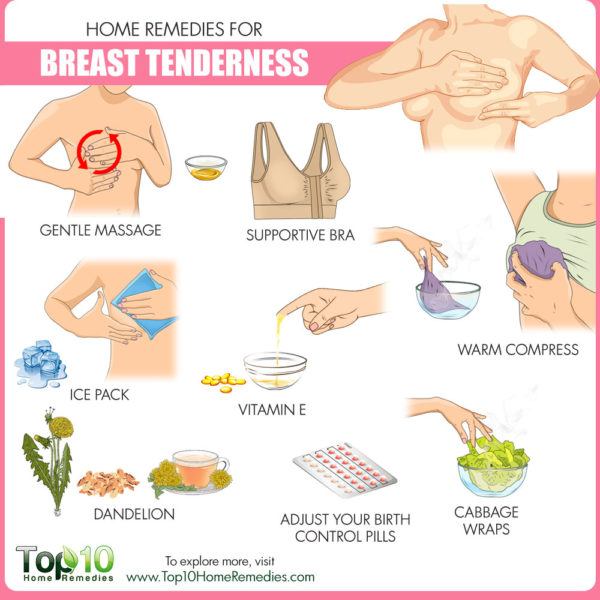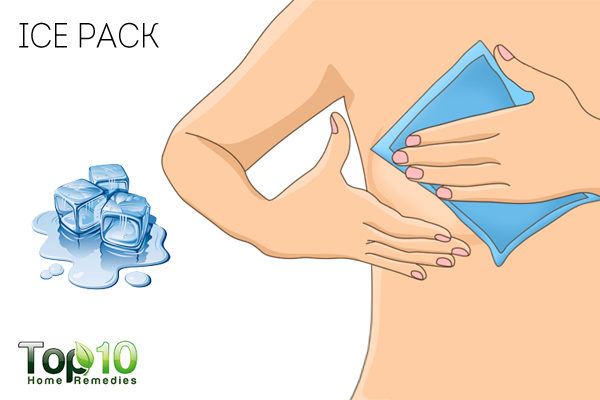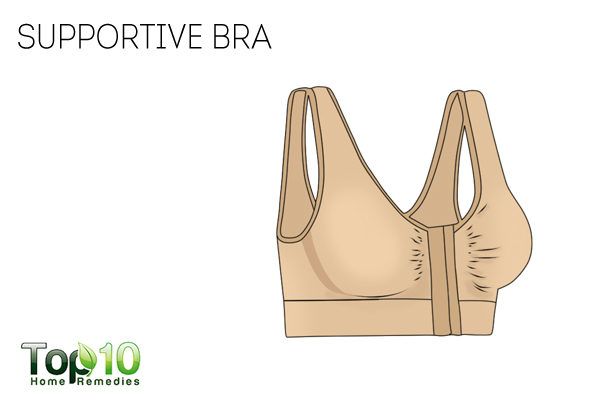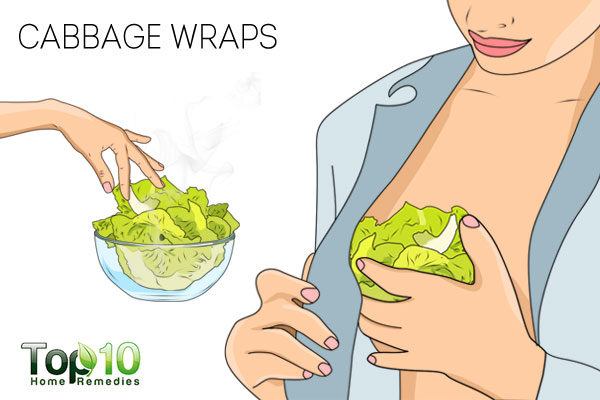Breast tenderness, also known as mastalgia, refers to softness in the
breast tissues accompanied by pain. The pain can arise either in the
breast tissue itself or can be referred pain, which means the pain is
felt in the breast but originates in another area.
Mastalgia is very common among women over the world and is rarely symptomatic of breast cancer. According to research, up to 70% of women will experience breast tenderness and pain at some time during their life.(1) Although postmenopausal women can also encounter sporadic episodes of breast tenderness, the condition is more common among younger women.

Here are some home remedies for managing breast tenderness and pain at home.

A massage helps to improve circulation, thereby reducing pain and tenderness. Additionally, it helps to reduce fluid retention, further reducing the discomfort.
A 2011 study published in the Journal of Korean Academy of Nursing reports that breast massage can be used to solve a variety of breast problems, including alleviating breast pain, decreasing breastmilk sodium, and improving newborn suckling. Nonetheless, more research is needed to validate these findings.(4)

An ice pack is especially beneficial for alleviating pain due to injury or fibrocystic breasts. The cold temperature helps numb the nerves around your breasts, reducing tenderness and dulling the pain.
On the other hand, using heat on tender breasts helps to relax sore muscles and reduce pain. A warm compress helps by improving blood circulation in the breasts.
Furthermore, a 2013 study suggested that alternative applications of warm and cool compresses to the affected breast encouraged milk flow and reduced discomfort.(5)
Another 2016 study published in the International Journal of Nursing Research and Practice demonstrated that hot fomentation was more effective in the reduction of breast engorgement whereas cold compression was found more effective in decreasing the pain intensity score due to breast engorgement among postnatal mothers.(6)

A 2014 study published in the International Journal of Family Medicine reports that inclusion of flaxseed in the diet appears to be an effective approach in decreasing cyclical mastalgia and works as a simple treatment with few complications.(8)
Another study published in the Journal of Education and Health Promotion in 2017 compared the effectiveness of flaxseed, evening primrose oil, and vitamin E in the treatment of breast pain. Flaxseed was subsequently found to exhibit considerable competency for pain management.(9)

In a 2008 study published in the Indian Journal of Community Medicine, researchers found that cold cabbage leaves as well as alternating hot and cold compresses both can be used in the treatment of breast engorgement. However, alternating hot and cold compresses displayed greater potency in reducing breast pain as compared to cold cabbage leaves.(10) Nevertheless, there is still some benefit to the application of cabbage leaves for the alleviation of breast discomfort.

So, if you are experiencing breast tenderness after starting new birth control pills, you may have to change your birth control pills. Consult your doctor about reducing or eliminating the estrogen component of your pills. In some cases, you may need to switch your method of birth control – talk with your doctor prior to any changes in your regimen.
Additional Tips
Source Click here
Mastalgia is very common among women over the world and is rarely symptomatic of breast cancer. According to research, up to 70% of women will experience breast tenderness and pain at some time during their life.(1) Although postmenopausal women can also encounter sporadic episodes of breast tenderness, the condition is more common among younger women.
Contents
Causes
- It is common to experience breast tenderness prior to your menstrual cycle, during pregnancy, while breastfeeding, and after menopause. This type of breast pain is cyclical. Cyclical breast pain fluctuates due to changes in your hormone levels and is the most common type of breast pain.(2)
- Hormone-related breast pain is due to surges in estrogen. Estrogen promotes breast tissue growth. Estrogen dominance can be due to several factors, such as excess body fat, too much stress, constipation, inadequate dietary fiber intake, reduced liver detoxification of hormones, environmental exposures to toxins, and nutrient insufficiencies.
- One can suffer from noncyclical breast pain due to internal anatomical changes, such as an injury, surgery, and infections. It can also be related to the growth of large cysts in the breast.
- Other causes of tender breasts include a condition called fibrocystic (lumpy) breasts, your diet, shoulder or muscle pain, chest congestion, certain medications, smoking, and poorly fitted bras.
Symptoms
- Breast tenderness can cause considerable discomfort (especially while moving) as well as heaviness, soreness, and increased sensitivity of the breasts.
- Cyclical breast pain occurs in both the breasts, but noncyclical breast pain can occur in just one breast or both breasts.
- The pain may be sharp or dull, but it is often located in one specific area referred to as the trigger zone.
- Pain linked to hormonal changes typically subsides during or after your menses or pregnancy. Noncyclical pain symptoms can vary in degree depending upon the cause, which can be more difficult to identify.(3)
Prevention
- Keep track of your symptoms to determine if your pain is cyclical or noncyclical and determine the treatment approach accordingly, in consultation with your doctor.
- Maintaining a healthy body weight can help prevent and even alleviate breast pain and tenderness to some extent.
- Experiment with relaxation therapy, which can help control high levels of anxiety often associated with tender and painful breasts.
- Fiber helps remove excess estrogen from the body. Hence, include more fiber-rich foods in your diet.
- Try to eat more organic foods.
- High-stress levels can lead to lower progesterone production and increased estrogen levels, so keep your stress level under control.
- Watch your sodium intake. Sodium increases water retention, which can cause your breasts to swell and become tender.
- Quit smoking, as tobacco use can further amplify the breast pain.
When to see a doctor
- If you are experiencing localized breast pain that has persisted for weeks with no relief, please visit your doctor.
- If the breast pain is sudden and accompanied by chest, jaw, or neck pain, seek immediate medical attention as it could be the sign of a heart attack.
- If you have a family history where your mother, maternal aunts, or sisters suffered from breast cancer, please seek medical attention for further analysis of your symptoms.
- If you notice skin discoloration or nipple discharge on the affected breast, consult your doctor immediately.

Here are some home remedies for managing breast tenderness and pain at home.
1. Gentle Massage
Many times, muscle pain in the chest or upper body can contribute to breast tenderness. In these instances, a simple massage can be quite helpful.
A massage helps to improve circulation, thereby reducing pain and tenderness. Additionally, it helps to reduce fluid retention, further reducing the discomfort.
A 2011 study published in the Journal of Korean Academy of Nursing reports that breast massage can be used to solve a variety of breast problems, including alleviating breast pain, decreasing breastmilk sodium, and improving newborn suckling. Nonetheless, more research is needed to validate these findings.(4)
- Apply a small amount of warm olive or coconut oil on your breasts.
- Gently massage one of your breasts using upward strokes, followed by circular motions.
- Repeat on the other breast in a similar pattern.
- Do this 2 or 3 times a day until your condition improves.
Note: Always massage your breasts gently and never do a deep tissue massage.
2. Hot and Cold Compresses
To deal with breast tenderness and pain, both hot and cold compresses have been proven effective.
An ice pack is especially beneficial for alleviating pain due to injury or fibrocystic breasts. The cold temperature helps numb the nerves around your breasts, reducing tenderness and dulling the pain.
On the other hand, using heat on tender breasts helps to relax sore muscles and reduce pain. A warm compress helps by improving blood circulation in the breasts.
Furthermore, a 2013 study suggested that alternative applications of warm and cool compresses to the affected breast encouraged milk flow and reduced discomfort.(5)
Another 2016 study published in the International Journal of Nursing Research and Practice demonstrated that hot fomentation was more effective in the reduction of breast engorgement whereas cold compression was found more effective in decreasing the pain intensity score due to breast engorgement among postnatal mothers.(6)
- Prepare a hot compress by wrapping a hot water bottle in a thin towel.
- Prepare a cold compress by wrapping a few ice cubes in a thin towel.
- Now place the hot compress on the tender breast for 15 minutes.
- Next, apply the cold compress for 5 minutes.
- Repeat the cycle 2 or 3 times.
- Use this remedy as needed.
3. Wear the Right Bra
An uncomfortable or poorly fitted bra can also give rise to mild breast pain and tenderness. If you suddenly suffer from mild breast tenderness for no apparent reason, consider changing your bra. In fact, it has been found that many women wear the wrong bra size, which may result in pain, discomfort, and irreversible sagging. This was corroborated by a 2008 survey published in the journal Chiropractic & Osteopathy wherein 80% of the women sampled were found wearing bras that were the wrong size.(7)
- It is recommended not to wear a bra that is too tight or has underwires. Instead, opt for a soft sports bra or a well-padded bra without underwires to support your tender breasts.
- Wear a sports bra while exercising, especially when your breasts are extra sensitive. If needed, wear your sports bra to bed to reduce nighttime jostling as well.
- When shopping for a new bra, make sure it cups your breasts perfectly and does not pinch your breasts.
- Always throw away old and stretched-out bras, as they do not provide the adequate support your breasts need.
4. Flaxseed
A tablespoon of ground flaxseed a day is a simple yet effective treatment for breast pain associated with one’s menstrual cycle. Flaxseeds contain phytoestrogens that aid in balancing hormones in the body and decrease breast pain. It is a good source of fiber, which helps to eliminate estrogen from the body.A 2014 study published in the International Journal of Family Medicine reports that inclusion of flaxseed in the diet appears to be an effective approach in decreasing cyclical mastalgia and works as a simple treatment with few complications.(8)
Another study published in the Journal of Education and Health Promotion in 2017 compared the effectiveness of flaxseed, evening primrose oil, and vitamin E in the treatment of breast pain. Flaxseed was subsequently found to exhibit considerable competency for pain management.(9)
- Include 1–2 tablespoons of flaxseed in your diet.
5. Cabbage Wraps
Cabbage leaves are a soothing remedy for swollen and tender breasts. The sulfur and kaempferol compounds found in cabbage help to reduce inflammation and swelling and are especially beneficial for nursing mothers who are prone to breast engorgement and clogged ducts.
In a 2008 study published in the Indian Journal of Community Medicine, researchers found that cold cabbage leaves as well as alternating hot and cold compresses both can be used in the treatment of breast engorgement. However, alternating hot and cold compresses displayed greater potency in reducing breast pain as compared to cold cabbage leaves.(10) Nevertheless, there is still some benefit to the application of cabbage leaves for the alleviation of breast discomfort.
- Gently clean your cabbage leaves prior to use.
- Dip 2 or 3 cabbage leaves into a bowl of warm water for 3 to 5 minutes.
- Take out one leaf and wrap it around your tender breast.
- When the leaf reaches room temperature, replace it with a new warm one.
- Do this 2 or 3 times a day to get fast relief from breast tenderness.
6. Adjust Your Birth Control Pills
Most oral contraceptives contain a combination of two hormones – estrogen and progestin – that are naturally found in women’s bodies. One of the side effects of oral contraceptives is breast tenderness.(11)
So, if you are experiencing breast tenderness after starting new birth control pills, you may have to change your birth control pills. Consult your doctor about reducing or eliminating the estrogen component of your pills. In some cases, you may need to switch your method of birth control – talk with your doctor prior to any changes in your regimen.
Additional Tips
- Low-impact exercises such as swimming and yoga (Surya Namaskar, or Sun Salutation pose) can help relieve breast pain and tenderness by improving the lymphatic flow in the body. The lymph nodes tend to swell due to hormonal changes.(12)
- Reduce your intake of methylxanthine, a component found in foods like coffee, cola, tea, wine, beer, bananas, chocolate, cheese, peanut butter, mushrooms, and pickles. This compound is believed to contribute to breast pain.(13)
- Drink ginger tea or fennel tea 2 or 3 times a day.
- Acupressure may help get rid of breast tenderness, soreness, and pain.
- Eat a low-fat diet and more complex carbohydrates. Eat more fresh vegetables and fruits that are high in antioxidants to prevent free-radical damage.
- Drink ample water throughout the day to help flush toxins out of the body.
Source Click here
Comments
Post a Comment